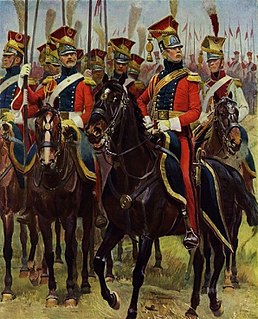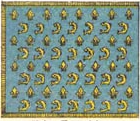 W
WThe 1st Regiment of the Line or (Italian: 1° Reggimento della Linea ) was a line infantry regiment of the Royal Army of Naples. The regiment was the first infantry regiment formed by the small kingdom, but by 1811 gained a reputation as an exemplary infantry regiment, and was reformed with the honorary title of "King's Own, or del Re". After the disastrous Neapolitan War, the regiment was disbanded, having never seen action outside of the Napoleonic Wars.
 W
WThe 2e régiment de chevau-légers lanciers de la Garde Impériale was a light cavalry regiment in Napoleon I's Imperial Guard. They were formed in 1810, after the Kingdom of Holland was annexed by France, but their original purpose was to serve as hussars of the Dutch Royal Guard. The units, who were of an elite order, were known for their loyalty and military might, as well as their professionalism in and out of battle.
 W
WThe 2nd Regiment of Riflemen was a unit of the U.S. Army in the early nineteenth century. It was first activated in 1814 during the War of 1812 when the War Department created three additional rifle regiments based on the success of the Regiment of Riflemen. The regiment was deactivated in May 1815.
 W
WThe 3rd Regiment of Riflemen was a unit of the U.S. Army in the early nineteenth century. It was first activated in 1814 during the War of 1812 when the War Department created three additional rifle regiments based on the success of the Regiment of Riflemen. The regiment never fought and was deactivated in May 1815.
 W
WThe 4th Regiment of Riflemen was a unit of the U.S. Army in the early nineteenth century. It was first activated in 1814 during the War of 1812 when the War Department created three additional rifle regiments based on the success of the Regiment of Riflemen. The regiment was deactivated in May 1815.
 W
WThe Army of the North or Armée du Nord is a name given to several historical units of the French Army. The first was one of the French Revolutionary Armies that fought with distinction against the First Coalition from 1792 to 1795. Others existed during the Peninsular War, the Hundred Days and the Franco-Prussian War.
 W
WThe Chasseurs à Cheval de la Garde Impériale constituted a light cavalry regiment in the Consular, then Imperial Guard during the French Consulate and First French Empire respectively. They were the second senior "Old Guard" cavalry regiment of the Imperial Guard, after the Grenadiers à Cheval. The regiment had its origins in the Guides raised by General Bonaparte during his Italian Campaign of 1796. It was the Chasseurs that usually provided personal escort to Napoleon, and he often wore the uniform of the regiment in recognition of this service. The regiment was not only known for its lavish uniform, but its combat history as well.
 W
WThe Commander-in-Chief, North Sea was senior appointment and an operational command of the British Royal Navy originally based at Great Yarmouth from 1745 to 1802 then at Ramsgate from 1803 until 1815.
 W
WThe Corps of Observation of the Vendée was a field formation of the French Imperial Army, which took part in the 1815 Vendéen Revolt, one of the minor campaigns of the Hundred Days. Following the end of the War of the Seventh Coalition, the corps was disbanded.
 W
WThe 1st Cuirassier Regiment was the oldest armoured regiment in the French Army, until it was amalgamated with 11th Cuirassiers Regiment. Today its traditions are carried on by the 1st Cuirassier Squadrons Group of the 1st-11th Cuirassier Regiment.
 W
WThe 3rd Cuirassier Regiment was a cavalry regiment of the French Army, later reequipped as an armored regiment.
 W
WThe Dragons de la Garde impériale was a heavy cavalry unit formed by Napoleon I through the decree of April 15, 1806. The "dragoon" regiments of the line had distinguished themselves in the German Campaign of 1805, and therefore Napoleon decided to reorganize the cavalry of the Guard and create within it a regiment of dragoon guards. This regiment was colloquially known as the Dragons de l'Impératrice, in honor of Empress Joséphine. Following the Bourbon Restoration, they were renamed Corps royal des Dragons de France but were disbanded shortly afterwards. The Empress' Dragoons were reformed during the Second Empire (1852-1870).
 W
WThe Dutch Grenadiers were a French Imperial Guard regiment during the Napoleonic Wars. They were originally formed out of Louis Bonaparte's royal guard in the Kingdom of Holland.
 W
WThe Éclaireurs of the Guard was a Corps of cavalry scouts of the French Imperial Guard, which included three cavalry regiments created by Napoleon when he reorganised the Imperial Guard following the disaster of the 1812 campaign in Russia. The Corps was created in Article I of the decree of 4 December 1813.
 W
WThe Gendarmes d'élite de la Garde impériale was a gendarmerie unit formed in 1801 by Napoleon as part of the Consular Guard which became the Imperial Guard in 1804. In time of peace, their role was to protect official residences and palaces and to provide security to important political figures. In time of war, their role was to protect the Imperial headquarters, to escort prisoners and occasionally to enforce the law and limit civil disorder in conquered cities. The unit was renamed Gendarmes des chasses du roi during the First Bourbon Restoration but was disbanded in 1815 during the Second Restoration.
 W
WThe Grenadiers à Cheval de la Garde Impériale constituted a heavy cavalry regiment in the Consular, then Imperial Guard during the French Consulate and First French Empire respectively. They were the senior Old Guard cavalry regiment of the Imperial Guard and from 1806 were brigaded together with the Dragons de la Garde Impériale.
 W
WThe Imperial Guard was originally a small group of elite soldiers of the French Army under the direct command of Napoleon I, but grew considerably over time. It acted as his bodyguard and tactical reserve, and he was careful of its use in battle. The Guard was divided into the staff, infantry, cavalry, and artillery regiments, as well as battalions of sappers and marines. The guard itself as a whole distinguished between the experienced veterans and less experienced members by being separated into three sections: the Old Guard, Middle Guard and Young Guard.
 W
WThe Indies Brigade or Indian Brigade, also referred to as the Dutch Indies Brigade or Netherlands Indies Brigade, was a short-lived Dutch-Belgian military unit which took part in the Waterloo Campaign and subsequent invasion of France in 1815.
 W
WThe Lithuanian Tatars of the Imperial Guard were a light cavalry unit of Napoleon's Imperial Guard, in the service of the French Army from 1812 to 1814. The Lithuanian Tatars, descendants of Crimean Tatars, were organized into a single squadron at the beginning of the Russian Campaign. Their first commander was Squadron Leader Achmatowicz, who was killed at Vilna and succeeded by Captain Ulan, who led the unit through the remainder of the war. The Lithuanian Tatars were disbanded during the First Bourbon Restoration.
 W
WMajor D'Aquin's Battalion of Free Men of Color was a Louisiana militia battalion made up of refugees from Haiti, which fought in the Battle of New Orleans during the War of 1812. Its nominal commander was Major Louis D'Aquin, a white man, but its combat commander was Captain Joseph Savary, a free man of color, who had been a Lieutenant-colonel in the French army. The battalion distinguished itself during the American night attack of December 23, 1814, and during the main battle of January 8, 1815. After the battle Andrew Jackson praised the colored soldiers, and especially Captain Savary for their efforts. When the city authorities prohibited colored troops from participating in the victory celebrations, Captain Savary nevertheless led his men in the victory parade through the streets of New Orleans.
 W
WThe Mamelukes of the Imperial Guard were a cavalry unit that served in Napoleon I’s Imperial Guard during the Napoleonic Wars. Originally made up of Mameluk slave soldiers, the unit eventually was mostly recruited from a wide mixture of Middle Eastern and European soldiers. Originally only mustering a single squadron, a second squadron would be raised from European cavalrymen in 1813, both squadrons served under the Regiment of Chasseurs a Cheval of the Imperial Guard.
 W
WThe Neapolitan Regiment of Honour Guards was a royal bodyguard unit of the Royal Neapolitan Guard, and was in turn part of the wider Neapolitan Army. The regiment was formed following the succession of Joachim Murat, and would continue to act as the official bodyguard under different designations until its eventual disbandment in 1815 following the disastrous Neapolitan War.
 W
WThe Old Guard were the veteran elements of the Emperor Napoleon's Imperial Guard. As such it was the most prestigious formation in Napoleon's Grande Armée. French soldiers often referred to Napoleon's Old Guard as "the Immortals".
 W
WThe 1st Parachute Hussar Regiment is an airborne cavalry unit in the French Army, founded in 1720 by Hungarian noble Ladislas Ignace de Bercheny. It is stationed in Tarbes and is a part of the 11th Parachute Brigade.
 W
WThe Dauphin's Cavalry Regiment (Régiment du Dauphin Cavalerie) was a line, later heavy cavalry regiment of the French Royal Army, and the last of its type to be formed by the time of the French Revolution. The regiment's successor, the 12th Cuirassier Regiment saw service in the Napoleonic Wars in all the major battles of the conflict before disbanding following the Second Restoration. However, the lineage was transferred following the restoration to the 2nd Cuirassier Regiment.
 W
WRoll's Regiment was a regiment of the British Army formed of Swiss, French and German soldiers raised in 1794 for service in the French Revolutionary Wars. The regiment's colonel was Louis de Roll, a former officer of the pre-revolutionary French Swiss Guards. The unit served in various garrisons in the Mediterranean and saw action in Tuscany before being reduced to a single battalion. The regiment was dispatched to Egypt in 1800 to oppose the French occupation and distinguished itself in action at the Battle of Alexandria. The regiment received drafts of French and Polish prisoners of war to replace its losses and in 1810 participated in the British invasion of the Septinsular Republic. The regiment served in Sicily as guard to Ferdinand IV of Naples before joining the Peninsular War. It saw action at the capture of Fort St Felipe and the 1813 Siege of Tarragona. The regiment disbanded at Corfus in 1815 following the end of the Napoleonic Wars.
 W
WThe Voltigeurs were French military skirmish units created in 1804 by Emperor Napoleon I. They replaced the second company of fusiliers in each existing infantry battalion.